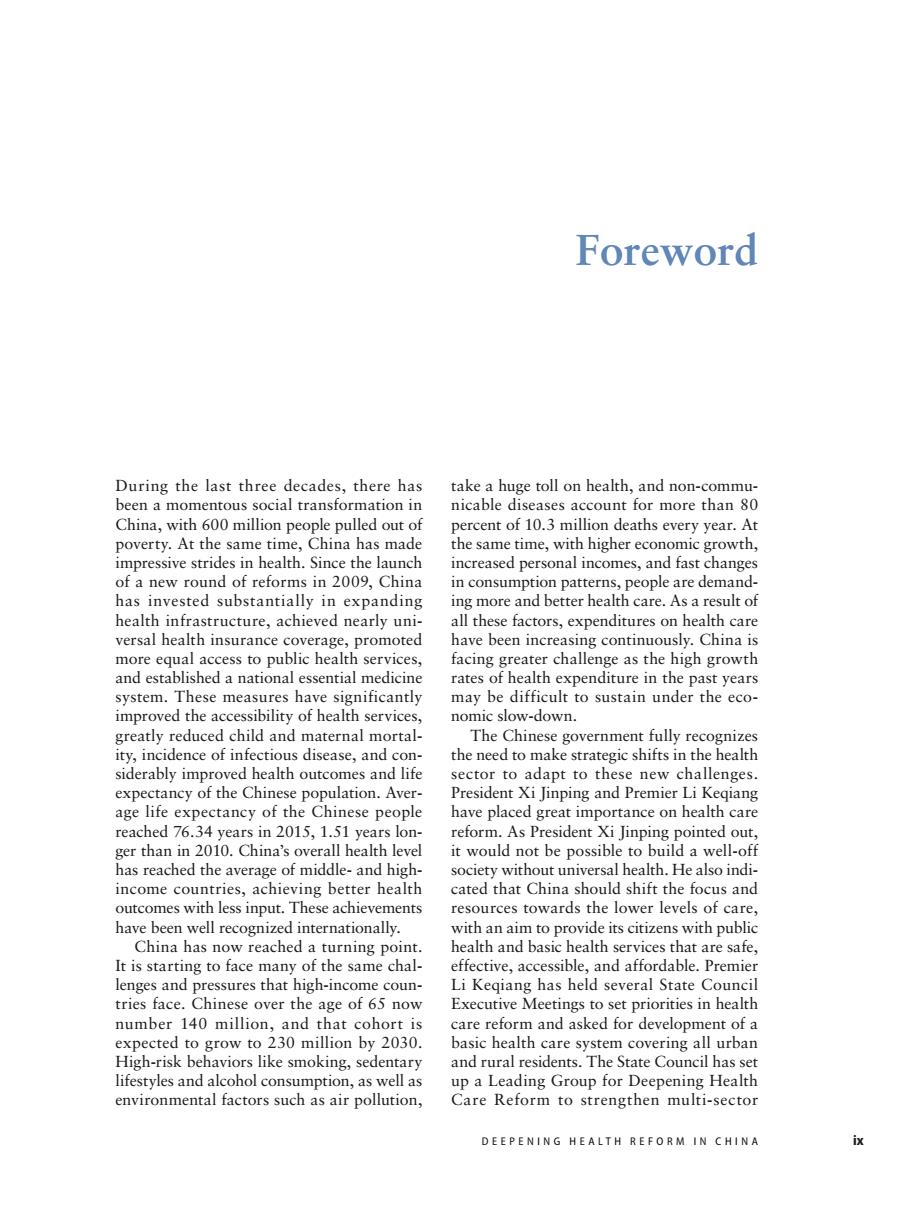正在加载图片...

Foreword During the last three decades,there has take a huge toll on health,and non-commu- been a momentous social transformation in nicable diseases account for more than 80 China,with 600 million people pulled out of percent of 10.3 million deaths every year.At poverty.At the same time,China has made the same time,with higher economic growth, impressive strides in health.Since the launch increased personal incomes,and fast changes of a new round of reforms in 2009,China in consumption patterns,people are demand- has invested substantially in expanding ing more and better health care.As a result of health infrastructure,achieved nearly uni- all these factors,expenditures on health care versal health insurance coverage,promoted have been increasing continuously.China is more equal access to public health services, facing greater challenge as the high growth and established a national essential medicine rates of health expenditure in the past years system.These measures have significantly may be difficult to sustain under the eco- improved the accessibility of health services, nomic slow-down. greatly reduced child and maternal mortal- The Chinese government fully recognizes ity,incidence of infectious disease,and con- the need to make strategic shifts in the health siderably improved health outcomes and life sector to adapt to these new challenges. expectancy of the Chinese population.Aver- President Xi Jinping and Premier Li Keqiang age life expectancy of the Chinese people have placed great importance on health care reached 76.34 years in 2015,1.51 years lon- reform.As President Xi Jinping pointed out, ger than in 2010.China's overall health level it would not be possible to build a well-off has reached the average of middle-and high- society without universal health.He also indi- income countries,achieving better health cated that China should shift the focus and outcomes with less input.These achievements resources towards the lower levels of care, have been well recognized internationally. with an aim to provide its citizens with public China has now reached a turning point. health and basic health services that are safe, It is starting to face many of the same chal- effective,accessible,and affordable.Premier lenges and pressures that high-income coun- Li Kegiang has held several State Council tries face.Chinese over the age of 65 now Executive Meetings to set priorities in health number 140 million,and that cohort is care reform and asked for development of a expected to grow to 230 million by 2030. basic health care system covering all urban High-risk behaviors like smoking,sedentary and rural residents.The State Council has set lifestyles and alcohol consumption,as well as up a Leading Group for Deepening Health environmental factors such as air pollution, Care Reform to strengthen multi-sector DEEPENING HEALTH REFORM IN CHINA ixDEEPENING HEALTH REFORM IN CHINA ix During the last three decades, there has been a momentous social transformation in China, with 600 million people pulled out of poverty. At the same time, China has made impressive strides in health. Since the launch of a new round of reforms in 2009, China has invested substantially in expanding health infrastructure, achieved nearly universal health insurance coverage, promoted more equal access to public health services, and established a national essential medicine system. These measures have significantly improved the accessibility of health services, greatly reduced child and maternal mortality, incidence of infectious disease, and considerably improved health outcomes and life expectancy of the Chinese population. Average life expectancy of the Chinese people reached 76.34 years in 2015, 1.51 years longer than in 2010. China’s overall health level has reached the average of middle- and highincome countries, achieving better health outcomes with less input. These achievements have been well recognized internationally. China has now reached a turning point. It is starting to face many of the same challenges and pressures that high-income countries face. Chinese over the age of 65 now number 140 million, and that cohort is expected to grow to 230 million by 2030. High-risk behaviors like smoking, sedentary lifestyles and alcohol consumption, as well as environmental factors such as air pollution, take a huge toll on health, and non-communicable diseases account for more than 80 percent of 10.3 million deaths every year. At the same time, with higher economic growth, increased personal incomes, and fast changes in consumption patterns, people are demanding more and better health care. As a result of all these factors, expenditures on health care have been increasing continuously. China is facing greater challenge as the high growth rates of health expenditure in the past years may be difficult to sustain under the economic slow-down. The Chinese government fully recognizes the need to make strategic shifts in the health sector to adapt to these new challenges. President Xi Jinping and Premier Li Keqiang have placed great importance on health care reform. As President Xi Jinping pointed out, it would not be possible to build a well-off society without universal health. He also indicated that China should shift the focus and resources towards the lower levels of care, with an aim to provide its citizens with public health and basic health services that are safe, effective, accessible, and affordable. Premier Li Keqiang has held several State Council Executive Meetings to set priorities in health care reform and asked for development of a basic health care system covering all urban and rural residents. The State Council has set up a Leading Group for Deepening Health Care Reform to strengthen multi-sector Foreword